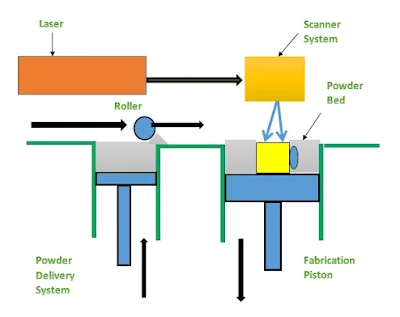- Liquid based AM
- Solid based AM
- Powder based AM
Liquid based AM
 |
| SLA Process (Image Source: laserfocusworld.com). |
 |
| Solid Ground Curing Process (image Source: hisour.com). |
Solid based AM
 | |
| Fused Filament Fabrication process (Dolores R Serrano et al.) | . |
 |
| Laminated Object Manufacturing (LOM) (Image source: custompartnet). |
Powder based AM
 |
| Selective Laser Sintering Process (Image Source: manufactur3dmag.com). |
Although, as per ASTM standard F2797, 3D printing methods are categorized into seven groups:
- Extrusion based Processes
- Material Jetting Processes
- Powder Fusion based Processes
- Vat Polymerization Processes
- Sheet Lamination Processes
- Direct Energy Deposition Processes
- Binder Jetting Processes
S.No. |
Category |
3D Printing Processes |
| 1 |
Extrusion based Processes |
Fused Deposition Modelling (FDM) or Fused Filament Fabrication (FFF) |
| 2 |
Material Jetting Processes |
Material Jetting |
| 3 |
Powder Fusion based Processes |
Direct Metal Laser Sintering (DMLS), Electron Beam Melting (EBM),
Selective Heat Sintering (SHS), Selective Laser Melting (SLM) and
Selective Laser Sintering (SLS). |
| 4 |
Vat Polymerization Processes |
Stereolithography (SLA) |
| 5 |
Sheet Lamination Processes |
Ultrasonic Additive Manufacturing (UAM) and Laminated Object Manufacturing (LOM) |
| 6 |
Direct Energy Deposition Processes |
Laser Engineered Net Shaping (LENS), Directed Light Fabrication, Direct Metal Deposition, 3D Laser Cladding |
| 7 |
Binder Jetting Processes |
3DP Technology |
References
- Krishnanand, Taufik M. (2021) Fused Filament Fabrication (FFF) Based 3D Printer and Its Design: A Review. In: Deepak B.B.V.L., Parhi D.R.K., Biswal B.B. (eds) Advanced Manufacturing Systems and Innovative Product Design. Lecture Notes in Mechanical Engineering. Springer, Singapore. https://doi.org/10.1007/978-981-15-9853-1_41
Comments
Post a Comment